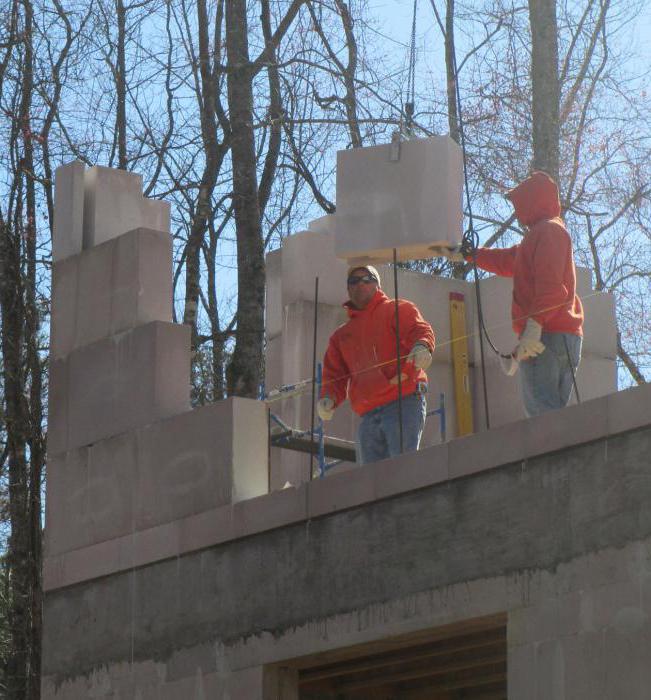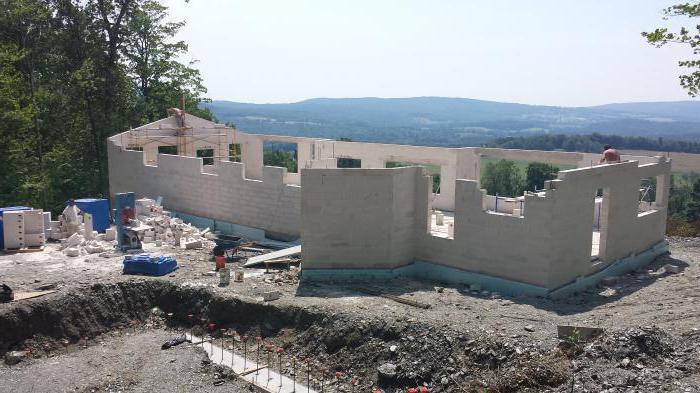Thickness of walls from aerated concrete. How to calculate the thickness of bearing walls from aerated concrete? Aerated concrete blocks - pros and cons
Aerated concrete blocks, the pros and cons of which will beconsidered in the article, differ from traditional concrete in that their thermal conductivity is rather low. This quality is achieved due to the fact that among the ingredients there is aluminum powder. Throughout the mixture in the process of solidification, hydrogen bubbles are distributed, so aerated concrete transmits heat much worse than conventional concrete. However, this advantage leads to a reduction in strength, which is relevant in comparison with conventional concrete. Therefore, when calculating wall thickness, it is necessary to take into account the required level of thermal insulation and wall strength. It is important to comply with the budget.
Choice of a variety of aerated concrete blocks for different walls

Depending on what is the purpose of the room and what requirements are imposed on the thermal insulation of the walls and their strength, the aerocrete blocks can be designed for erecting:
- garages;
- auxiliary rooms;
- summer cottages intended for living in the summer;
- residential buildings.
For the first three categories of thermal insulationthe quality of the walls is not so important, therefore, choosing the thickness, you need to focus on strength. As the density increases, the strength increases and the thermal conductivity of the blocks increases.
Block classes

Having become acquainted with the assortment of the market, you will be able to understand that aerated concrete can belong to one of the following classes:
- В3,5 is a material that is intended for bearing walls of houses in 5 floors;
- B2.5 are used as a material for bearing walls, if the height of the house is not more than 3 floors;
- В2,0 is aerated concrete, which is used for construction of bearing walls with a height of no more than 2 floors.
Depending on the density, the blocks can be attributed to the brand within the D300 to D1200. The number next to the letter indicates the density in kg / m3. High density indicates that beforeyou constructive blocks, capable of undergoing a heavy load. Blocks with a lower density can be used as a self-supporting heater.
Regulatory requirements

Construction using cellular concreteregulated STO 501-52-01-2007. Recommendations for the use of aerated concrete blocks require the determination of the permissible wall height. If autoclaved cellular blocks are used in the construction, the bearing walls can have a height of up to 5 floors or 20 m. The self-supporting walls can have a height of 30 m or 9 floors.
In the norms you will be able to find strengthblocks depending on the number of storeys. To build the inner and outer walls of the five-story building, it is necessary to use products whose strength corresponds to the indicator B3.5. The grade of the solution should be equal to M100 and higher. The class of cellular concrete in three-story buildings should be B2.5; the solution class corresponds to the value M75. For the construction of self-supporting walls it is necessary to use blocks of class B2,5. The norms mentioned above take into account only the strength of the question; As for the thermal insulation, this side is not illuminated.
Choosing a wall thickness

If you are thinking about the question of howcalculate the thickness of the wall of aerated concrete, then you should know that you need to take into account the heat engineering indicators and strength. However, it is rather difficult to manage this task independently. In this case, you can focus on the approximate values of thickness and strength, which will depend on the purpose. If you compare with other materials, the aerated concrete wall will have a smaller thickness and equal energy efficiency.
Having familiarized with the Russian constructionnorms, you will learn that the thickness of walls of aerated concrete should be 44 cm, while a brick wall will have a thickness equal to 51-64 cm. In expanded clay and wood, these values are equal to 90 cm and 53 cm, respectively. Walls with this thickness will equally prevent heat loss. These recommendations are averaged, they are compiled on the basis of statistics.
If you are wondering about what thicknessthere must be walls made of aerated concrete, then you should pay attention to the experience of some developers. For the erection of single-storey houses, garages and summer kitchens in warm climates, aerated concrete is sometimes used, the thickness of which is 200 mm. However, this value can not be called recommended. Even for non-residential premises aerated concrete 300 mm thick is used.
Additional recommendations for determining the thickness of walls

For the walls of basement floors and basementsuse material of brand D600, whereas the thickness of the block can be equal to the limit from 300 to 400 mm. If you are going to erect inter-apartment partitions, their thickness can be from 200 to 300 mm, with the use of B2.5 blocks, which correspond to brands within D500-D600. Internal walls made of aerated concrete, the thickness of which varies from 100 to 150 mm, are built from blocks B2,5, while their brand corresponds to the limit from D500 to D600. When partitions are erected in an existing room, it is best to prefer D300 aerated concrete. In this case, sound insulation, rather than strength, is of great importance.
The recommended wall thickness of aerated concrete should beTo be considered and at erection of uninhabited premises by type of summer kitchens and garages. When carrying out work, it is necessary to use D500 aerated concrete, the thickness of which starts from 200 mm. The final value will depend on the load.
Calculation of wall thickness

The thickness of the outer walls of aerated concrete can becalculated independently. For this, it is necessary to know the standardized value of the resistance to heat transfer for a certain region (Rreq, m2 × ° C / W), as well as the coefficient of thermal conductivity of the blocks (λ, W / (m∙ ° C) .The thickness is calculated by multiplying these values. hygienic comfort, the resistance to heat transfer must be equal to or greater than the normalized value, which is determined by the following formula: Rreq = coefficient a * Dd + coefficient b. In it, Dd is the degree-day of the heating period.This value is determined by the method of multiplying the quantities and the days per degree for a specific locality.The coefficient a is 0.00035, while the second coefficient is 1.4 All these values are given in the sanitary norms and regulations on 23-02-2003.
When the thickness of the bearing walls is determined fromaerocrete, it is necessary to take into account the thermal conductivity of the material, which depends on the density. The more dense aerated concrete, the higher the level of its thermal conductivity. The most common in the cottage building aerated concrete blocks of the brand M500. They are structural and thermal insulation.
Very strong blocks of the brand M600, they possesshigh thermal conductivity, which indicates that they will pass a large amount of heat from the room. For thermal insulation it is better to use blocks M400, because they have a large number of pores, whose volume in the total mass exceeds 75%. This indicates that the material is excellent in keeping heat, but has a low level of strength.
Advantages of aerocrete blocks

When the thickness of walls of aerated concrete is calculated, yoube sure to ask what are the advantages and disadvantages of the material you use. Among other advantages, it is necessary to allocate a high level of thermal insulation. It is on him that the main focus is consumers and suppliers. The aerated concrete wall has a lower cost compared to that built from bricks, but the thermal insulation properties of these structures can be equal.
The thickness of the walls of aerated concrete should not be youpay yourself. Normative values can be used for this. Additional advantages of the described material are high accuracy and impressive sizes of products. All this allows you to build walls with high speed and with minimal deviations. The cost of external finishing will be reduced, and the use of products with grooves will eliminate the formation of cracks and bridges of cold.
Another important advantage is thethe possibility of refusing to use cement mortar for masonry. The material is very resistant to fire, has a low weight and is fairly easy to handle. It is environmentally safe, characterized by biological stability and frost resistance.
Cons of aerocrete blocks
The thickness of walls made of aerated concrete is sufficientimportant minus the described material. The minimum value for the Moscow region is 535 mm. It is important at the same time to take into account the cold bridges, which will give an additional 10% reduction in protection. The wall must necessarily have reinforced belts and bridges to strengthen the openings, this also reduces the level of thermal insulation by 10-30%. As a result, you will have to build a wall, the thickness of which is 65 cm.
Aerated concrete blocks, the pros and cons of which youshould be taken into account before the beginning of construction, are quite often used today for the erection of residential buildings and structures for different purposes. But you must remember that the material has a high hygroscopicity. This minus can be called one of the main.
Conclusion
After reading the regulatory documents, youyou can understand that in the central regions of Russia it is possible to erect single-layer aerated concrete walls. As for Siberia and the northern regions, two-layer and three-layer structures are usually built there. Now you know what thickness should be the walls of aerated concrete. But before acquiring this material, you should definitely familiarize yourself with its pros and cons, the latter of which quite often force consumers to choose their choice in the direction of other materials.








